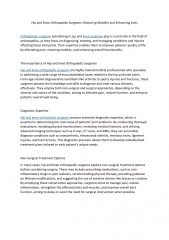Hip Imaging Basics: MRI Techniques and Sequences for Bilateral Examination
This content presents a quiz on hip imaging basics focusing on MRI techniques and sequences for bilateral examination. It covers topics such as appropriate positioning, the use of Propeller sequences, and the best choice of sequence for labral arthro-MR study. Images and questions related to hip imaging are included in the quiz, providing a comprehensive overview of key considerations in hip MRI.
Download Presentation

Please find below an Image/Link to download the presentation.
The content on the website is provided AS IS for your information and personal use only. It may not be sold, licensed, or shared on other websites without obtaining consent from the author. Download presentation by click this link. If you encounter any issues during the download, it is possible that the publisher has removed the file from their server.
E N D
Presentation Transcript
QUIZ 4: Hip Imaging Basics Of MRI:How I Do It AFIIM -ISRA 2015
QUIZ 4: Hip Imaging For a appropriate position of hip bilateraI examination one answer is wrong: A. In axial plan the femoral necks are parallel to ischio-pubien part of pelvis B. In coronal plan the field of view begins to top of iliac crest to greater trochanter C. In coronal plan in the same slice femoral head, neck and diaphyse are seen together D. The lower limb is internal rotation Basics Of MRI:How I Do It AFIIM -ISRA 2015
QUIZ 4: Hip Imaging For a appropriate position of hip bilateraI examination one answer is wrong: A. In axial plan the femoral necks are parallel to ischio-pubien part of pelvis B. In coronal plan the field of view begins to top of iliac crest to greater trochanter C. In coronal plan in the same slice femoral head, neck and diaphyse are seen together D. The lower limb is internal rotation Basics Of MRI:How I Do It AFIIM -ISRA 2015
QUIZ 4: Hip Imaging When a bilateral study of hip is more appropriate than an unilateral study with a surfacic coil? A. for labral study B. for aseptic osteonecrosis of femoral head C. for a prothetic implant D. for a snaping hip Basics Of MRI:How I Do It AFIIM -ISRA 2015
QUIZ 4: Hip Imaging When a bilateral study of hip is more appropriate than an unilateral study with a surfacic coil? A. for labral study B. for aseptic osteonecrosis of femoral head C. for a prothetic implant D. for a snaping hip Basics Of MRI:How I Do It AFIIM -ISRA 2015
QUIZ 4: Hip Imaging When you use Propeller sequence ? A. To get a larger field of view B. To increase spatial resolution C. To reduce artefacts of motion ( arteries, intestinal peristaltism) D. To decrease time of examination Basics Of MRI:How I Do It AFIIM -ISRA 2015
QUIZ 4: Hip Imaging When you use Propeller sequence ? A. To get a larger field of view B. To increase spatial resolution C. To reduce artefacts of motion ( arteries, intestinal peristaltism) D. To decrease time of examination Basics Of MRI:How I Do It AFIIM -ISRA 2015
QUIZ 4: Hip Imaging What is your best choice of sequence for labral arthro -MR study ?: A. PD FATSAT with 3mm thickness slice B. 3D sequence with strong T1W (FIESTA,TRUE FISP,BALANCED FFE) C. T1 FDE high resolution D. T1 FSE FATSAT Basics Of MRI:How I Do It AFIIM -ISRA 2015
QUIZ 4: Hip Imaging What is your best choice of sequence for labral arthro -MR study ?: A. PD FATSAT with 3mm thickness slice B. 3D sequence with strong T1W (FIESTA,TRUE FISP,BALANCED FFE) C. T1 FDE high resolution D. T1 FSE FATSAT Basics Of MRI:How I Do It AFIIM -ISRA 2015
QUIZ 4: Hip Imaging 35 year old man, right groin pain, with hip limitation. professionnal soccer player ( Paris -Saint Germain Team) Basics Of MRI:How I Do It AFIIM -ISRA 2015
QUIZ 4: Hip Imaging Ax T2 FS AP view Coro T2 FS Coro T2 FS Basics Of MRI:How I Do It AFIIM -ISRA 2015
QUIZZ Hip Imaging Only one proposition is incorrect: A. The sphericity of the two femoral heads are abnormal The symptomatology is referred to a potential Femoro Acetabular Impigment The high signal of the femoral neck is related to a potential Osteoid Osteoma An hip arthroraphy is needed ( MR or CT arthography) B. C. D. Basics Of MRI:How I Do It AFIIM -ISRA 2015
QUIZZ Hip Imaging Only one proposition is incorrect: A. The sphericity of the two femoral heads are abnormal The symptomatology is referred to a potential Femoro Acetabular Impigment The high signal of the femoral neck is related to a potential Osteoid Osteoma An hip arthroraphy is needed ( MR or CT arthography) B. C. D. Femoro Acetabular Impigement (FAI) Basics Of MRI:How I Do It AFIIM -ISRA 2015
QUIZ 4: Hip Imaging Femoro Acetabular Impigement (FAI) CAME type Basics Of MRI:How I Do It AFIIM -ISRA 2015
QUIZ 4: Hip Imaging Femoro-acetabular impigement (FAI) refers to a clinical syndrome of painful, limited hip motion resulting from certain types of underlying morphological abnormalities in the femoral head/neck Cam type: technically, the word "cam" refers to a bump on a rotating shaft that transmits force to another part of an engine Repetitiv micro traumatisme lead to labral and chondral anterior lesion (MR arthro) . This can lead to early degenerative disease. Ganz R, Leunig M, Leunig-ganz K et-al. The etiology of osteoarthritis of the hip: an integrated mechanical concept. Clin. Orthop. Relat. Res. 2008;466 Basics Of MRI:How I Do It AFIIM -ISRA 2015






















